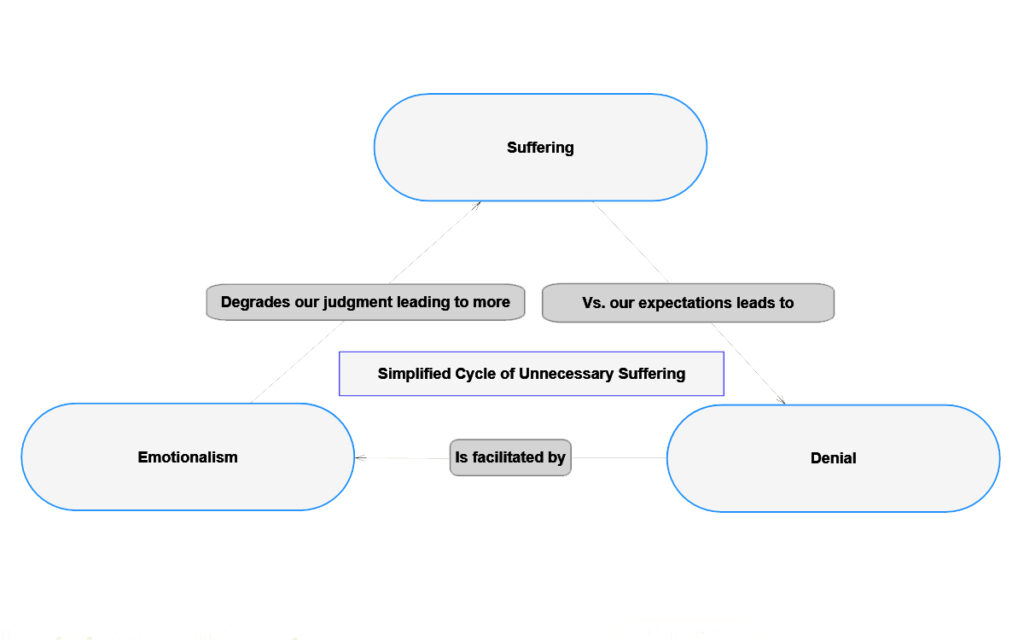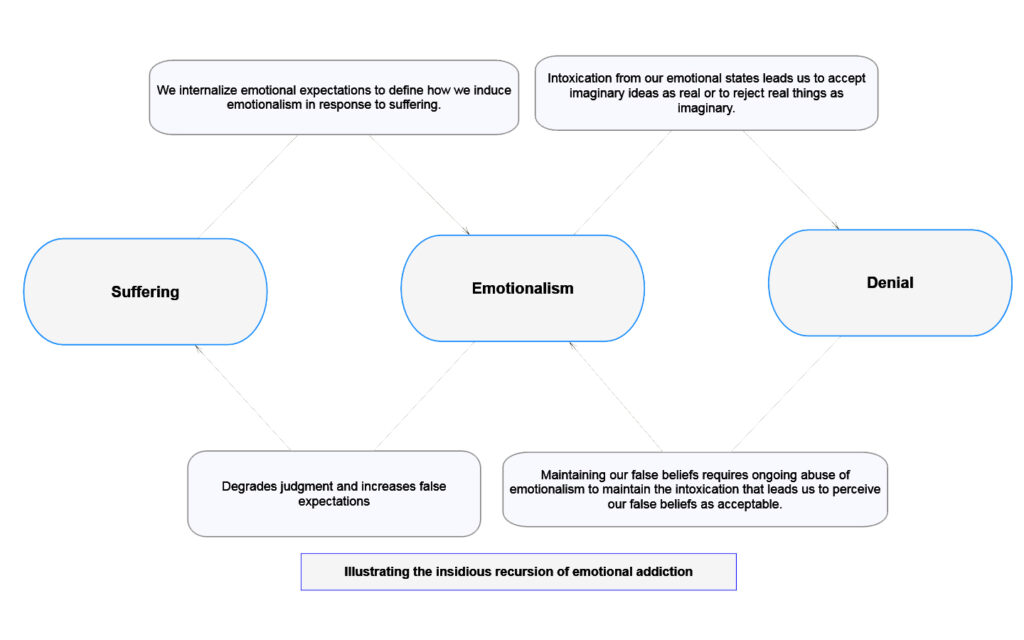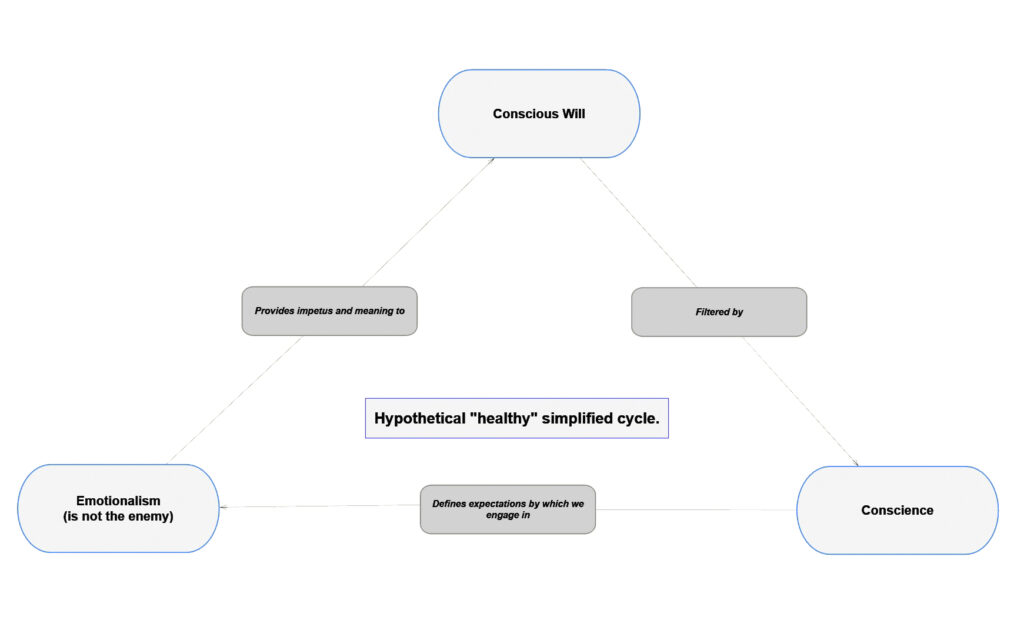There exists a great cycle of suffering running through humanity and extending outward into the living world surrounding us. While in the strictest sense this cycle is metaphorical, or perhaps allegorical, the experience of it and its impacts are very real. I’d ask you to think of this cycle I’m about to describe as a kind of template. It’s not a precise fit for every situation but it lends itself to most with a little reflection.
The cycle begins with suffering – always. It’s an inescapable aspect of existence for animal life capable of thinking and feeling to any discernible degree. Suffering in this context can be taken as any stimulus or circumstance aversive enough to prompt us to engage in denial. Depending on our beliefs and expectations the suffering required for denial to be appealing to us varies, but I think it is universally applicable as we each meet our threshold before long. Life is punctuated by traumatic events. If its rhythm were equitable we wouldn’t have such an easy time dismissing it in favour of our feelings.
Thought precedes emotion – always. Complicating this is the rapidity at which we can think, particularly when stressed. We often pretend our emotions come unbidden because it can genuinely feel like they do when we don’t know it can be any different. Whether our emotions of the moment feel pleasant or miserable they always feel compelling and we can amplify this effect by inducing stronger emotional responses. We are free to choose these things every waking moment of our lives, with a few exceptions. It’s our rejection of our responsibility for making good and healthy emotional choices that leads to so much unnecessary suffering.
When confronted with suffering we choose our response based in large part on our expectations and beliefs. On this scale our expectations and beliefs are like rules we internalize and grant the same (or even greater) importance as we do facts. We think generally think our expectations are real and realistic and we often feel quite entitled to our expected outcomes. These beliefs and expectations form our held moral values and their quality (or honesty) directly correlates to our ability to engage in emotional self control. As most of us live today we reject these ideas and we pursue more and stronger emotions through our work and our entertainment, and through just about every aspect of our lives. We’re taught to believe that emotions are a reward unto themselves and to impart them with great meaning. We took it too far and abused it to reject our own and each other’s humanity and incorporated these beliefs and expectations into our commonly held worldviews.
To make our denials and rejections of the real “make sense” and feel appropriate to us we must first addle our brains with emotions. Our most common response to suffering is along the lines of “This isn’t happening (to me)” or “This isn’t real” or “This isn’t important (because [some imaginary idea])”. So we think these things and we think “This makes me angry!” or “Now I’m frustrated!” or “This is so sad!” and we induce the emotion of choice in rejection of the real thing that offends us. As the emotions run their course we scramble to make our denials feel appropriate so we can divert ourselves to something else.
It should be obvious that this process seriously degrades our decision making capacity. The attendant beliefs undermine how we value conscience, which is the mechanism by which we would normally police ourselves for such dishonest thinking. On these scales dishonesty equates to errors we introduce into our brains and when we make choices based on errors the impacts of our choices fail to align with our physical reality and our expectations. People inevitably suffer more – whether ourselves or those around us – our poor choices based on dishonest beliefs always contribute to the unnecessary suffering extant in our world. And there has never been a shortage of it since our sapient qualities emerged.
So what do we do? We compound our mistakes. We double down on denial and emotionalism. We reject the suffering wrought by our own choices by engaging in more denial and more extreme emotionalism to maintain our denial. We go on making poorer and poorer choices even as we intoxicate ourselves on intolerable emotions. We become resistant to course correction – refusing to see that our excessive emotionalism is a big part of the problem. Universally, we feel entitled to our emotionalism even when our choices lead us to cede control of it. We find the idea of feeling less to be appalling and in my experience people are very quick to anger at the suggestion.
Yet I don’t think emotion is the enemy. It’s not the enemy of sapience nor of rationality. Emotions provide the same survival advantages they always have and also provide something we currently think we need in order to impart meaning to our experiences (at least until we devise a better way). We need to learn to be much more selective about the emotions we choose, their dose and schedule, and the frequency with which we induce them. This can be addressed by choosing to re-evaluate and edit our held moral values and the expectations and beliefs that support them. It’s a free choice we can begin to address anytime we want through self analysis and reflection – sitting and thinking – taking notes as may be appropriate. The process begins with recognition of the endogenous addiction because until we choose to see it we remain enthralled with our emotionalism to a degree and in styles that prevent us from the very kind of reflection we need in order to heal and move beyond these cycles.
Below is a diagram I made recently. It is a work in progress and not final in any way. I’m not asserting the depicted relationships between concepts as fact, although much of it illustrates how I see myself these days. I include it because while it is incomplete and a bit chaotic, I think it’s very useful and beneficial to conceptualize ourselves and our qualities in these ways, as systems with relationships. So for what it’s worth I include it below with the caveat that I may update it without notice here as I make improvements. It is a very large image and it may be necessary to open it in a new browser tab to view it full size in order to read it.



